This post contains affiliate links.
Hummingbirds have feathers that range from very tiny to very large by comparison.
This article takes a deep dive into the different types of feathers found on a hummingbird and how they differ from one another.
What is Unique About Hummingbirds’ Feathers
Hummingbirds have eight unique feathers that cover their entire body, each with its own special purpose. They are contour feathers, down feathers, tail feathers, remiges (wing feathers), gorget feathers, rump feathers, facial feathers, and articular feathers.
Hummingbird Contour Feathers:
The contour feathers, which are the body’s outermost feathers, give hummingbirds their distinctive shapes and colors. The contour feathers of the head and neck provide insulation and support the hummingbird’s aerodynamic form.
These feathers are special because they give the hummingbird its unique shape and coloring. The birds can fly through the air with little resistance thanks to their sleek and streamlined form.

Photo by: Mehta.vishal.360
Hummingbird Down Feathers:
Down feathers for hummingbirds are found below the contour feathers. Soft and fluffy down feathers provide excellent insulation and aid in regulating body temperature. In cold weather, their specific shape retains warm air close to the bird’s body to aid in maintaining a constant body temperature.
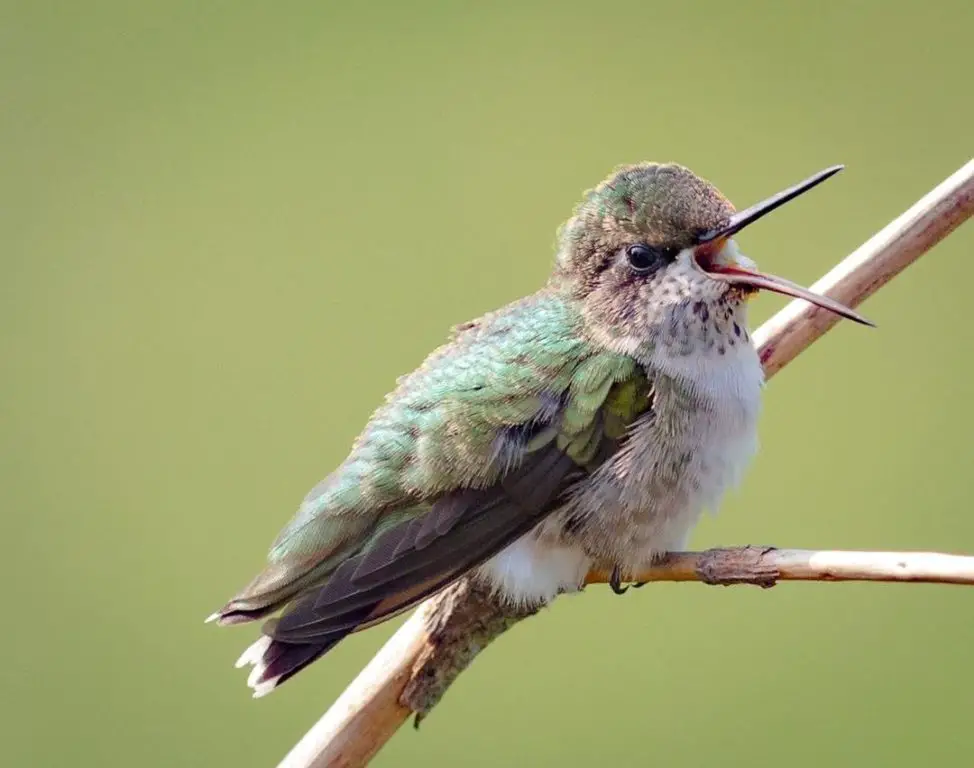
The down feathers are more visible
in this baby/juvenile than in an adult.
Hummingbird Tail Feathers:
Hummingbirds have 10 tail feathers. The two outermost tail feathers are called rectrices (flight feathers), and they are the longest. These tail feathers are unique and are long and narrow, aiding in precise maneuvering during flight. These feathers are crucial for controlling the hummingbird’s direction and stability.
Hummingbirds have specialized tail feathers that are designed to be more flexible and maneuverable than the feathers on other parts of their bodies.
The tail feathers of hummingbirds play a crucial role in the bird’s flight and agility. These feathers are attached to the tailbone and are highly modified for the purpose of flight control. These feathers are relatively stiff and have unique features that allow hummingbirds to make rapid, precise movements during hovering, rapid accelerations, and sharp turns in flight.
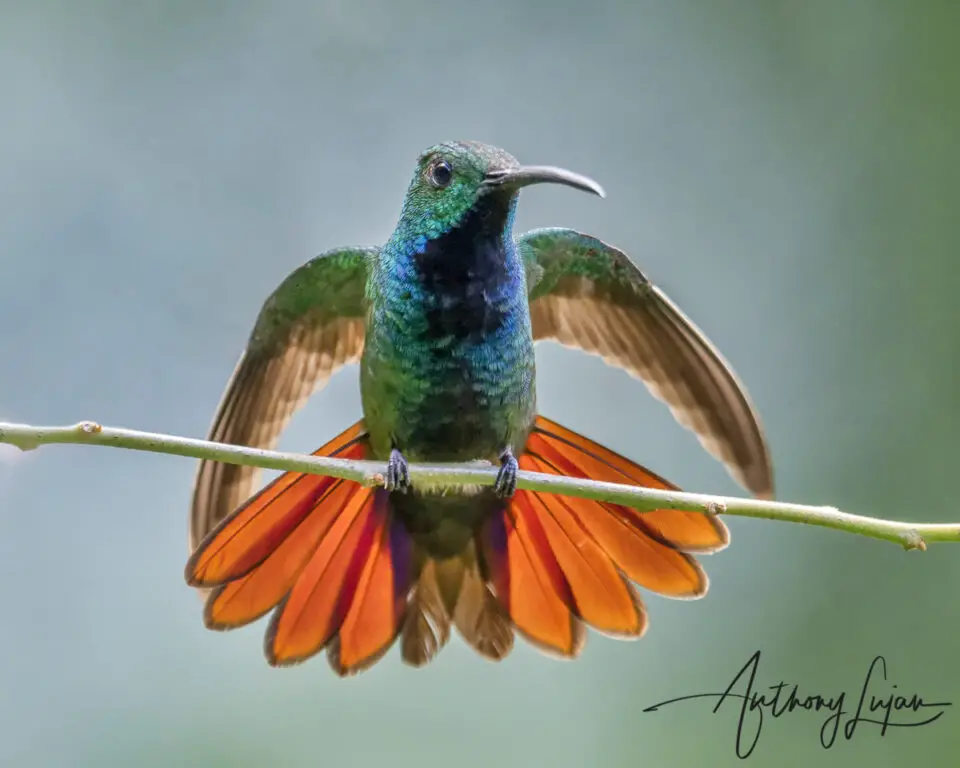
Male Green-breasted mango.
The stiff and specialized nature of hummingbirds’ tail feathers helps them maintain stability and control while hovering and maneuvering in mid-air.
In contrast, the contour feathers on other parts of a hummingbird’s body, such as its wings and back, are more flexible and provide insulation and streamlining for regular flight. These feathers are not as stiff as the tail feathers and serve different purposes in the bird’s overall flight mechanics.
There is speculation by some that the tail feathers of a hummingbird are more loosely attached for the purpose of being more easily detachable to escape when attacked from behind.
Hummingbird Remiges (Wing Feathers):
Remige feathers are unique because they are specialized for powered flight. They are long, stiff, and have a distinct shape, helping to generate lift and thrust during wing beats.
There are three main types of remiges feathers:
- Primaries: Located at the wing’s tip (outer edge), these are the longest and provide the majority of lift.
- Secondaries: These feathers are located behind the primaries and help with lift and stability.
- Tertiaries: These feathers are found closer to the body and provide additional support during flight.

Adult Female Anna’s hummingbird
Hummingbird Gorget Feathers:
Male gorget feathers are found on the throats of hummingbirds and are unique in their vibrant colors, often iridescent, which are specifically adapted for courtship displays. In addition to using them as mating displays, they are also used to ward off other males in their territory.
See my article: Hummingbird Gorgets Explained: The Complete Story
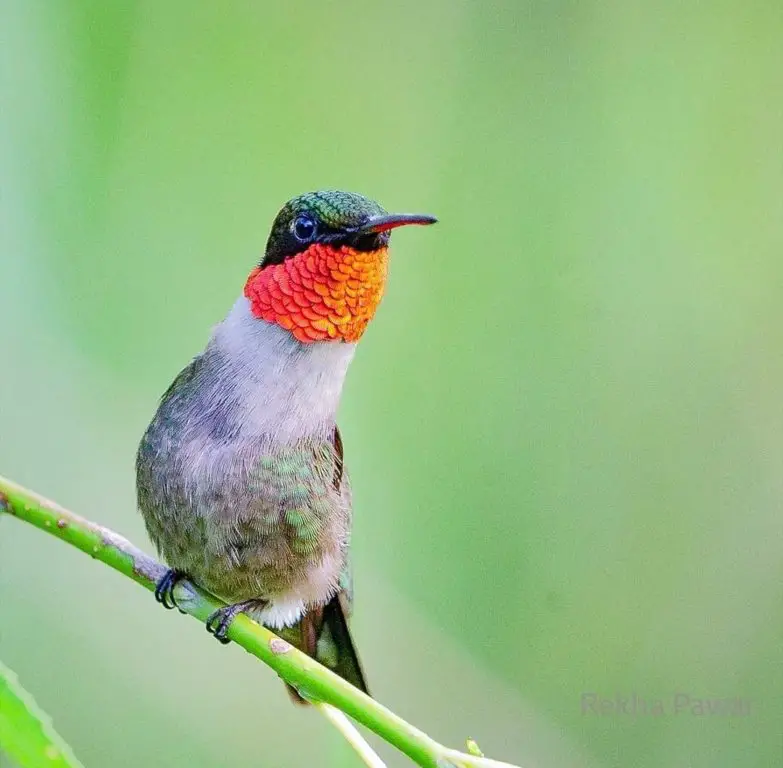
Adult Ruby-throated hummingbird showing off his gorget.
Hummingbird Rump Feathers:
These feathers cover the rump area and play a role in aerodynamics and insulation.
Along with providing additional insulation, they contribute to the bird’s streamlined shape, assisting in flight efficiency.
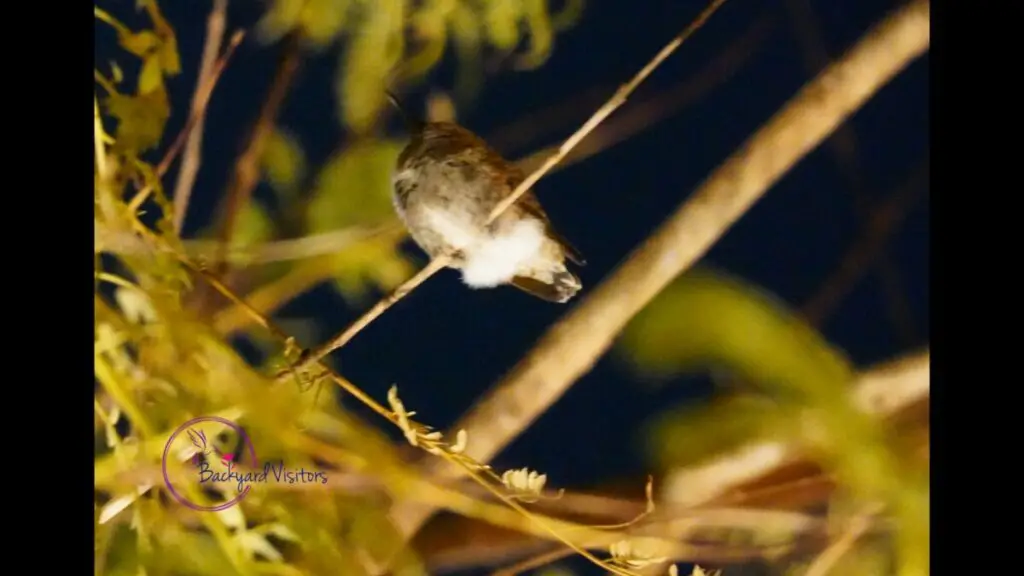
making it easy to identify it as a new baby fledgling.
Hummingbird Facial Feathers:
Facial feathers are unique in their location around the eyes and beak. They help protect the hummingbird’s sensitive facial areas from sun glare, wind, and debris during flight.
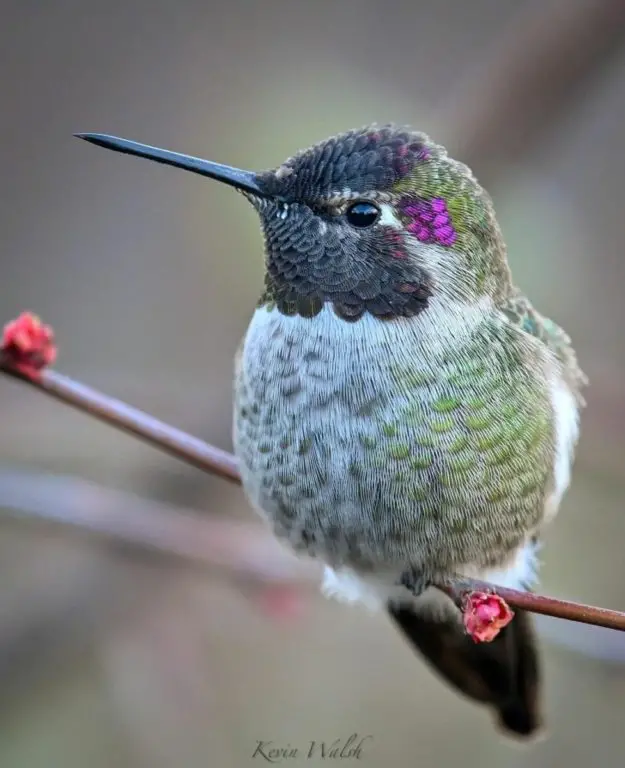
Baby/Juvenile Male Anna’s Hummingbird.
Hummingbird Auricular Feathers:
Auricular feathers, located around the ears, are unique in their role in protecting the ears from wind and noise during flight. They contribute to the hummingbird’s ability to navigate and communicate effectively.

Notice the auricular iridescent feathers behind the eye, indicating a juvenile.
What Determines The Color of a Hummingbird Feather?
Hummingbird feather colors result from unique melanosomes that interact with light to produce both iridescent and non-iridescent colors that are different for every species, distinguishing them from other vibrant birds that get their feather colors from pigments.
Hummingbird feathers are incredibly colorful due to their iridescent plumage and the unique structural composition of melanosomes in their plumage.
Unlike some other birds that get their feather colors from pigments, hummingbirds rely on the way light interacts with their melanosomes to create their known shimmering hues.
The color in a non-iridescent feather of a hummingbird, like in iridescent feathers, is also due to the melanosomes of the feather rather than the presence of pigments in the feather itself. The refraction of the sunlight is just not reflected as iridescent because of the fewer number of air cells within the melanosome.
Researchers, led by Chad Eliason from Chicago’s Field Museum of Natural History, embarked on a groundbreaking study to unravel the secrets of hummingbird feather coloration. They used electron microscopes to get a super-close look at feathers from 34 different hummingbird species.
Hummingbirds have tiny structures within their feather cells called melanosomes. These melanosomes are flat like pancakes filled with tiny air bubbles that interact with light and are responsible for the iridescence seen on hummingbird feathers.
An example of iridescence is the colorlessness of soap bubbles. When the soap bubbles are stretched out, they display glossy rainbow colors around the edges. Hummingbird melanosomes work in a similar fashion as their structure turns something colorless into something extremely colorful and iridescent.
Melanosomes are incredibly tiny – you could fit a staggering 100 million of them on a single hummingbird feather!
The vast diversity of colors in the hummingbird family is achieved by varying the arrangements and layerings of these air pockets and by altering the thickness of feather linings.
In contrast, feathers of other brilliantly colored avian species, characterized by tubular melanosomes with fewer air bubbles acquire their feather colors from pigments. This structural difference is why hummingbirds are so brilliantly iridescent compared to other birds.
How Do Hummingbird Feathers Change Color?
Hummingbird feathers change color by their iridescent feather’s ability to refract and reflect light as it strikes their feathers at different angles.
Hummingbird feathers change colors as sunlight is reflected from their melanosomes at different angles.
Only hummingbird’s iridescent feathers change colors. Their non-iridescent feathers do not change colors.
Hummingbird feathers have tiny layers of air bubbles called melanosomes. Melanosomes are minuscule organelles found inside the feather cells of hummingbirds. These pancake-shaped melanosomes are flat and loaded with little air bubbles that interact with sunlight to give hummingbird feathers their iridescent sheen and change of color.
As the hummingbird changes its position, the angle of light enters the melanosomes at a different angle causing it to change instantaneously. This combination of reflection and refraction makes the light travel in different directions and occasionally it will cross its own path giving the appearance of changing hues.
Male and female hummingbirds have different plumage.
Males are flashy with jewel-toned feathers that are meant to attract females and establish dominance over other males. They even have a colorful patch called a gorget on their throats. This gorget can shine with colors like red, purple, orange, blue, or pink, as sunlight bends or refracts off the feathers.
See my article: Hummingbird Gorgets Explained: The Complete Story
Female hummingbirds are more understated, with dull brown or green feathers, however, some species show a small iridescent gorget. Juvenile hummingbirds also start with these muted tones, which can sometimes lead to confusing them for females in the field. As juvenile hummingbirds mature their dull plain plumage tones change to develop vibrant bright colors depending on the species.
Are Hummingbird Feathers Waterproof?
Hummingbird feathers are not inherently waterproof like the feathers of waterfowl or aquatic birds but hummingbirds have several adaptations that help keep their feathers relatively dry. These adaptations include preening, oil glands, and a unique feather structure.
Preening:
Hummingbirds engage in preening behavior, during which they use their beaks to clean and maintain their feathers. This helps remove dirt and debris, which if allowed to accumulate will make the feathers less waterproof.

Photo by: Rekha Pawar
Oil Glands:
Hummingbirds, like other birds, have a specialized oil gland near the base of their tails where the tail feathers attach to the body called the uropygial gland. They use their beaks to spread the oil from this gland over their feathers during preening. This oil helps make their feathers more resistant to water, although it may not make them entirely waterproof.
Feather Structure:
The structure of a bird’s feathers also plays a role in shedding water. The outermost feathers, called the contour feathers, have a waterproof coating of microscopic structures that helps repel water to some extent.
While hummingbirds do not rely on their feathers for buoyancy like waterfowl, they do need to keep their feathers in good condition to maintain their ability to fly, stay warm, and display vibrant colors during courtship displays. While their feathers are not fully waterproof, these adaptations help hummingbirds manage moisture and maintain the functionality of their feathers.
In the enchanting world of birds, hummingbirds stand out as captivating aerial acrobats, flaunting their iridescent plumage and dazzling us with their lightning-fast flights. While their feathers may not be the epitome of waterproof, nature has bestowed upon these tiny wonders a set of ingenious adaptations that ensure their survival.
Hummingbirds employ a meticulous grooming ritual known as preening, where they use their dainty beaks to meticulously clean and maintain their feathers. This not only removes dirt and debris but also aids in distributing a special oil produced by their uropygial gland. This oil lends their feathers a degree of water resistance, helping them stay relatively dry during their high-speed forays.
The secret to this natural waterproofing of hummingbird feathers lies in the structure of their feathers. The outermost contour feathers of hummingbirds possess microscopic structures that function like a raincoat, causing water to bead up and roll off.
This feature, combined with their diligent preening, ensures their feathers remain in top-notch condition for efficient flight, temperature regulation, and even captivating courtship displays.
While hummingbirds may not rival ducks in their aquatic prowess, their feather adaptations showcase nature’s remarkable ability to tailor solutions to specific needs. These avian gems may not be fully waterproof, but they are a testament to the beauty of evolutionary design, enabling hummingbirds to thrive in their aerial realm.
Check out my other posts on Hummingbird Questions
Happy Hummingbird Feather Watching!
Backyard Visitors participates in affiliate programs which compensate us for referring traffic.

